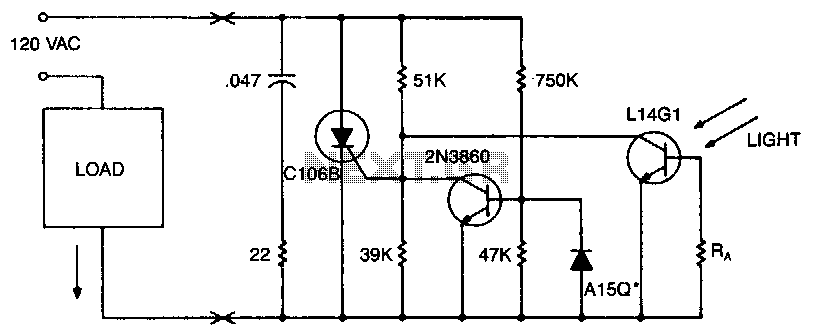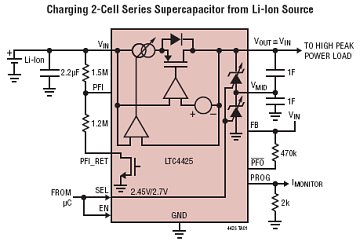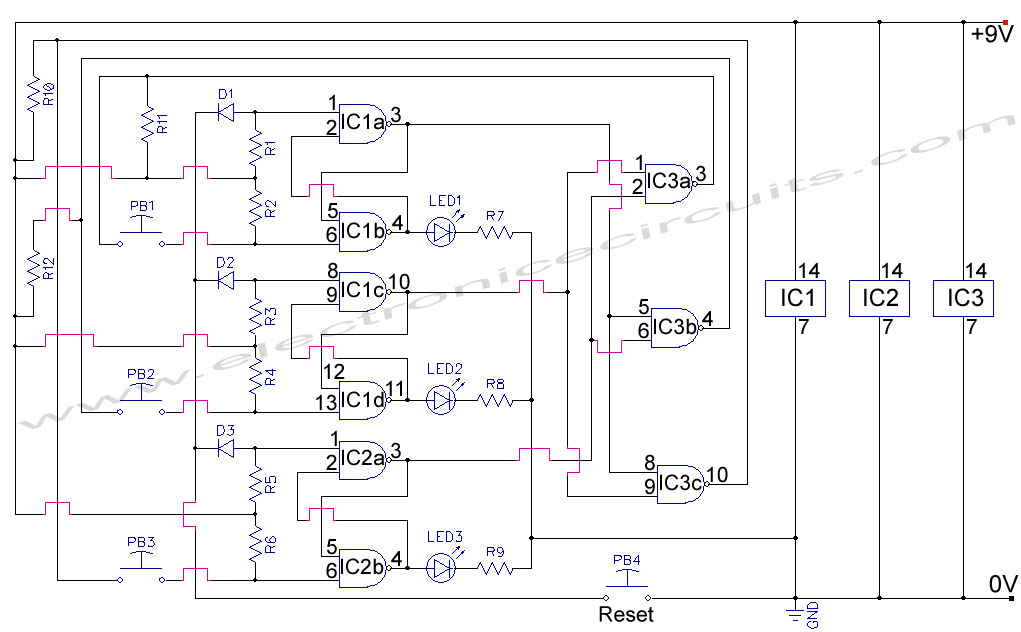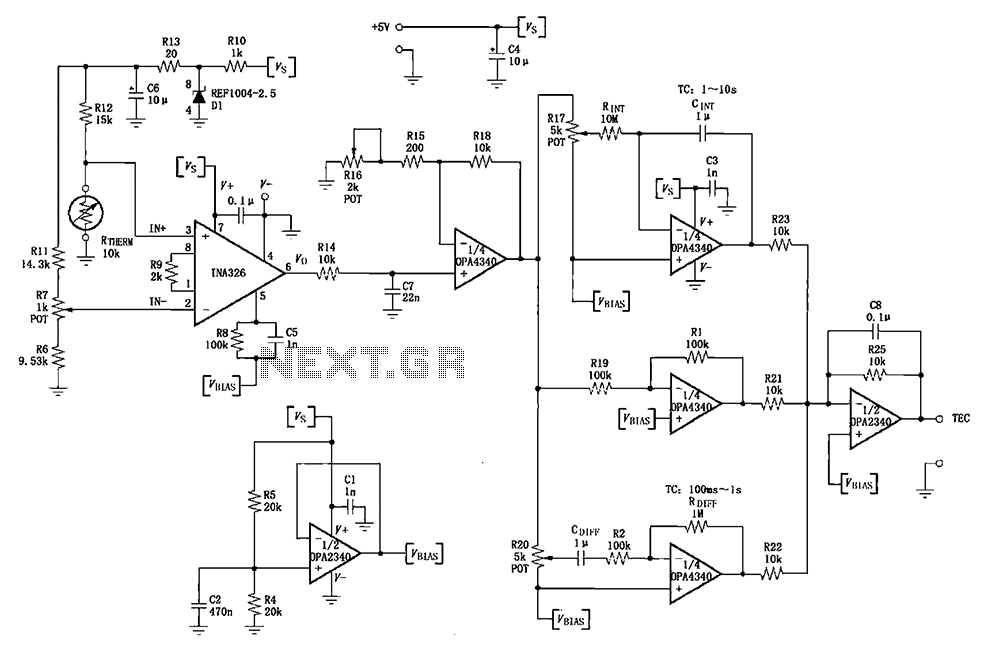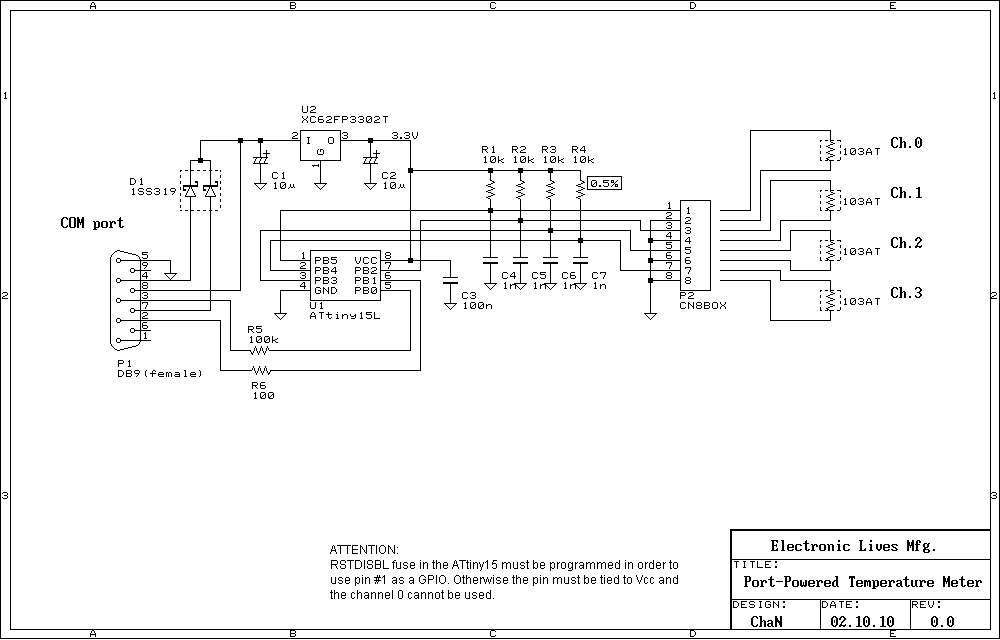
Dual over-under temperature monitor
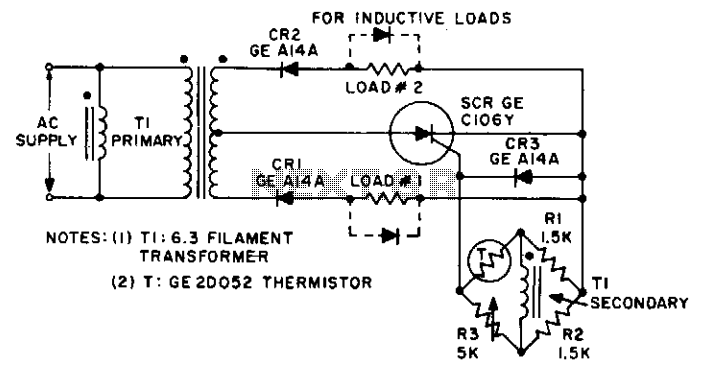
This circuit functions effectively as an over-under temperature monitor, utilizing its dual output capability to control HIGH and LOW temperature indicator lamps, relays, and similar devices. The transformer (Tl) operates at 6.3 volts and features a secondary winding connected within a four-arm bridge configuration. When the bridge is balanced, the AC output remains at zero, preventing any gate signal from reaching capacitors C5 or C7. However, if the bridge becomes unbalanced due to fluctuations in the thermistor's ambient temperature, an AC voltage will emerge across the gate-cathode terminals of the SCR. The phase of this positive gate voltage will either align with or be 180° out of phase with the AC supply, depending on the nature of the imbalance.
If the positive gate voltage is in phase, the SCR will allow current to flow through diode CR1 to load (1), while diode CR2 will block current to load (2). Conversely, if the positive gate voltage is 180° out of phase, diode CR2 will become conductive and supply power to load (2), with diode CR1 being reverse biased. With the specified component values, this circuit is capable of responding to temperature variations of approximately 1-2°C. It is also possible to replace the thermistor with other variable-resistance sensors, such as cadmium sulfide light-dependent resistors (LDR) or strain gauge elements.
The circuit design employs a four-arm bridge configuration, which is a fundamental method for measuring resistance changes due to temperature fluctuations. The use of a 6.3-volt transformer ensures that the circuit operates within a safe voltage range while providing sufficient output for the connected loads. The thermistor serves as a temperature-sensitive resistor, changing its resistance in response to temperature changes, thus affecting the balance of the bridge.
The SCR (Silicon Controlled Rectifier) plays a critical role in controlling the power delivered to the loads, acting as a switch that can be turned on or off by the gate voltage. The selection of diodes CR1 and CR2 is essential for directing the current flow appropriately based on the phase of the gate voltage. The circuit's ability to respond to a temperature change of 1-2°C makes it suitable for applications requiring precise temperature monitoring and control.
In summary, this over-under temperature monitoring circuit is versatile and can be adapted for various applications by substituting different types of variable-resistance sensors, thereby enhancing its functionality in temperature-sensitive environments.This circuit is ideal for use as an over-under temperature monitor, where its dual output feature can be used to drive HIGH and LOW temperature-indicator lamps, relays, etc. Tl is a 6.3 volt filament transformer whose secondary winding is connected inside a four arm bridge. When the bridge is balanced, ac output is zero, and C5 (or C7) receives no gate signal. If the bridge is unbalanced by raising or lowering the thermistor's ambient temperature, and ac voltage will appear across the SCR's gate cathode terminals.
Depending in which sense the bridge is unbalanced, the positive gate voltage will be in phase with, or 180° out of phase with the ac supply. If the positive gate voltage is in phase, the SCR will deliver load current through diode CRI to load (1), diode CR2 blocking current to load (2). Conversely, if positive gate voltage is 180° out of phase, diode CR2 will conduct and deliver power to load (2), CRI being reverse biased under these conditions.
With the component values shown, the circuit will respond to changes in temperature of approximately 1-2°C. Substitution of other variable-resistance sensors, such as cadmium sulfide light dependent resistors (LDR) or strain gauge elements, for the thermistor shown is permissible.
If the positive gate voltage is in phase, the SCR will allow current to flow through diode CR1 to load (1), while diode CR2 will block current to load (2). Conversely, if the positive gate voltage is 180° out of phase, diode CR2 will become conductive and supply power to load (2), with diode CR1 being reverse biased. With the specified component values, this circuit is capable of responding to temperature variations of approximately 1-2°C. It is also possible to replace the thermistor with other variable-resistance sensors, such as cadmium sulfide light-dependent resistors (LDR) or strain gauge elements.
The circuit design employs a four-arm bridge configuration, which is a fundamental method for measuring resistance changes due to temperature fluctuations. The use of a 6.3-volt transformer ensures that the circuit operates within a safe voltage range while providing sufficient output for the connected loads. The thermistor serves as a temperature-sensitive resistor, changing its resistance in response to temperature changes, thus affecting the balance of the bridge.
The SCR (Silicon Controlled Rectifier) plays a critical role in controlling the power delivered to the loads, acting as a switch that can be turned on or off by the gate voltage. The selection of diodes CR1 and CR2 is essential for directing the current flow appropriately based on the phase of the gate voltage. The circuit's ability to respond to a temperature change of 1-2°C makes it suitable for applications requiring precise temperature monitoring and control.
In summary, this over-under temperature monitoring circuit is versatile and can be adapted for various applications by substituting different types of variable-resistance sensors, thereby enhancing its functionality in temperature-sensitive environments.This circuit is ideal for use as an over-under temperature monitor, where its dual output feature can be used to drive HIGH and LOW temperature-indicator lamps, relays, etc. Tl is a 6.3 volt filament transformer whose secondary winding is connected inside a four arm bridge. When the bridge is balanced, ac output is zero, and C5 (or C7) receives no gate signal. If the bridge is unbalanced by raising or lowering the thermistor's ambient temperature, and ac voltage will appear across the SCR's gate cathode terminals.
Depending in which sense the bridge is unbalanced, the positive gate voltage will be in phase with, or 180° out of phase with the ac supply. If the positive gate voltage is in phase, the SCR will deliver load current through diode CRI to load (1), diode CR2 blocking current to load (2). Conversely, if positive gate voltage is 180° out of phase, diode CR2 will conduct and deliver power to load (2), CRI being reverse biased under these conditions.
With the component values shown, the circuit will respond to changes in temperature of approximately 1-2°C. Substitution of other variable-resistance sensors, such as cadmium sulfide light dependent resistors (LDR) or strain gauge elements, for the thermistor shown is permissible.
